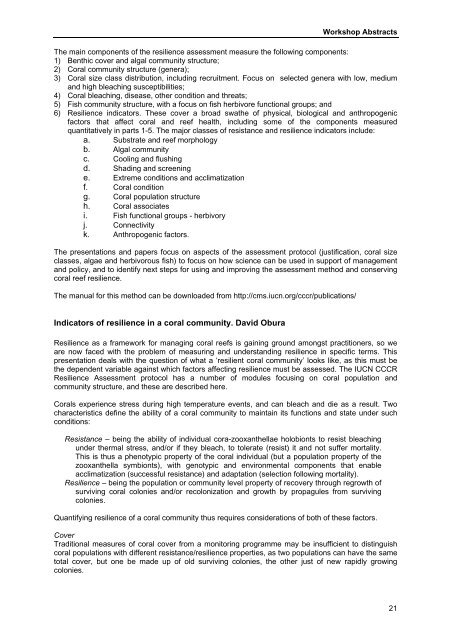Obura2009-IUCN Congress report - Resilience sessions
Obura2009-IUCN Congress report - Resilience sessions.pdf
Obura2009-IUCN Congress report - Resilience sessions.pdf
You also want an ePaper? Increase the reach of your titles
YUMPU automatically turns print PDFs into web optimized ePapers that Google loves.
Workshop Abstracts<br />
The main components of the resilience assessment measure the following components:<br />
1) Benthic cover and algal community structure;<br />
2) Coral community structure (genera);<br />
3) Coral size class distribution, including recruitment. Focus on selected genera with low, medium<br />
and high bleaching susceptibilities;<br />
4) Coral bleaching, disease, other condition and threats;<br />
5) Fish community structure, with a focus on fish herbivore functional groups; and<br />
6) <strong>Resilience</strong> indicators. These cover a broad swathe of physical, biological and anthropogenic<br />
factors that affect coral and reef health, including some of the components measured<br />
quantitatively in parts 1-5. The major classes of resistance and resilience indicators include:<br />
a. Substrate and reef morphology<br />
b. Algal community<br />
c. Cooling and flushing<br />
d. Shading and screening<br />
e. Extreme conditions and acclimatization<br />
f. Coral condition<br />
g. Coral population structure<br />
h. Coral associates<br />
i. Fish functional groups - herbivory<br />
j. Connectivity<br />
k. Anthropogenic factors.<br />
The presentations and papers focus on aspects of the assessment protocol (justification, coral size<br />
classes, algae and herbivorous fish) to focus on how science can be used in support of management<br />
and policy, and to identify next steps for using and improving the assessment method and conserving<br />
coral reef resilience.<br />
The manual for this method can be downloaded from http://cms.iucn.org/cccr/publications/<br />
Indicators of resilience in a coral community. David Obura<br />
<strong>Resilience</strong> as a framework for managing coral reefs is gaining ground amongst practitioners, so we<br />
are now faced with the problem of measuring and understanding resilience in specific terms. This<br />
presentation deals with the question of what a ‘resilient coral community’ looks like, as this must be<br />
the dependent variable against which factors affecting resilience must be assessed. The <strong>IUCN</strong> CCCR<br />
<strong>Resilience</strong> Assessment protocol has a number of modules focusing on coral population and<br />
community structure, and these are described here.<br />
Corals experience stress during high temperature events, and can bleach and die as a result. Two<br />
characteristics define the ability of a coral community to maintain its functions and state under such<br />
conditions:<br />
Resistance – being the ability of individual cora-zooxanthellae holobionts to resist bleaching<br />
under thermal stress, and/or if they bleach, to tolerate (resist) it and not suffer mortality.<br />
This is thus a phenotypic property of the coral individual (but a population property of the<br />
zooxanthella symbionts), with genotypic and environmental components that enable<br />
acclimatization (successful resistance) and adaptation (selection following mortality).<br />
<strong>Resilience</strong> – being the population or community level property of recovery through regrowth of<br />
surviving coral colonies and/or recolonization and growth by propagules from surviving<br />
colonies.<br />
Quantifying resilience of a coral community thus requires considerations of both of these factors.<br />
Cover<br />
Traditional measures of coral cover from a monitoring programme may be insufficient to distinguish<br />
coral populations with different resistance/resilience properties, as two populations can have the same<br />
total cover, but one be made up of old surviving colonies, the other just of new rapidly growing<br />
colonies.<br />
21


















